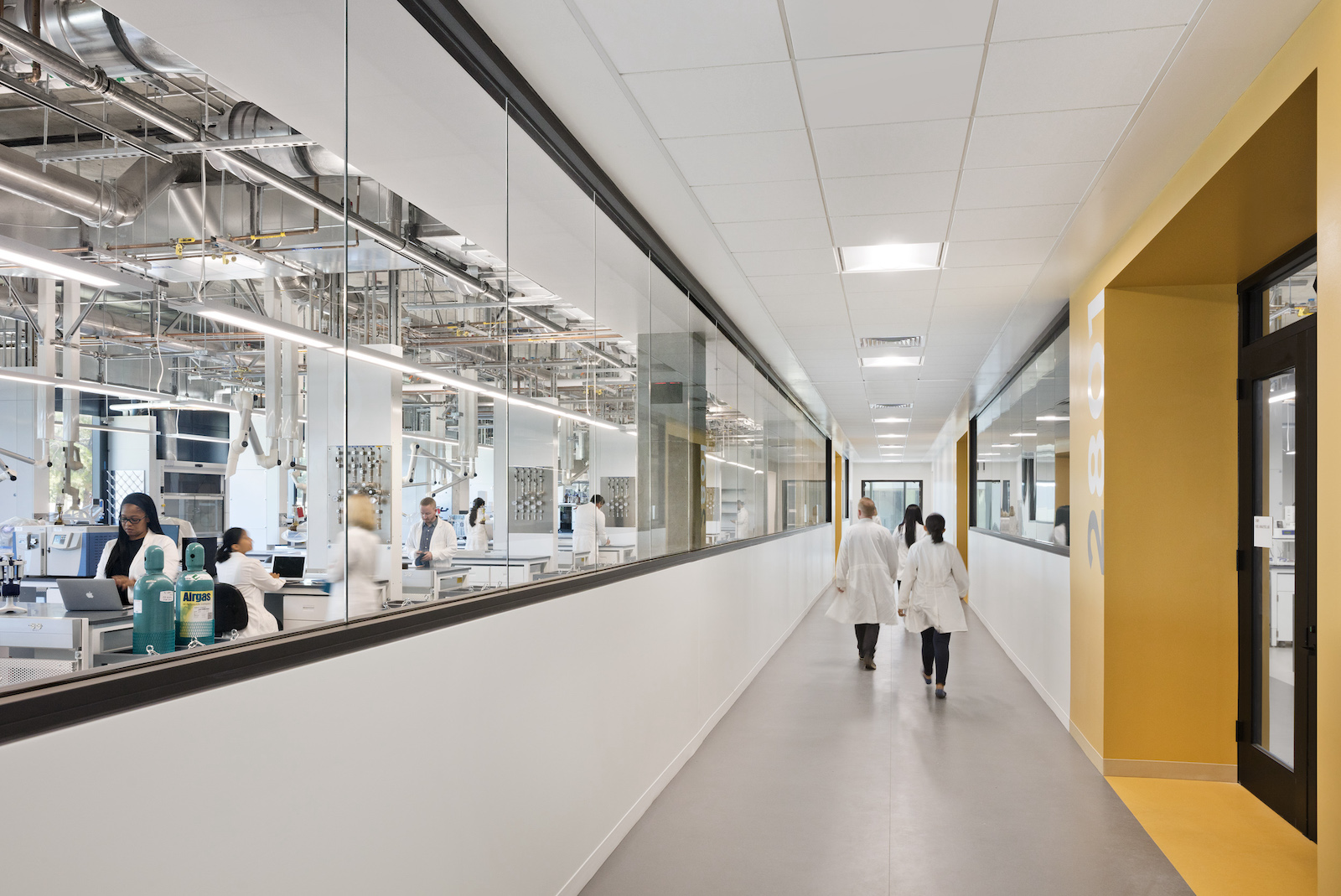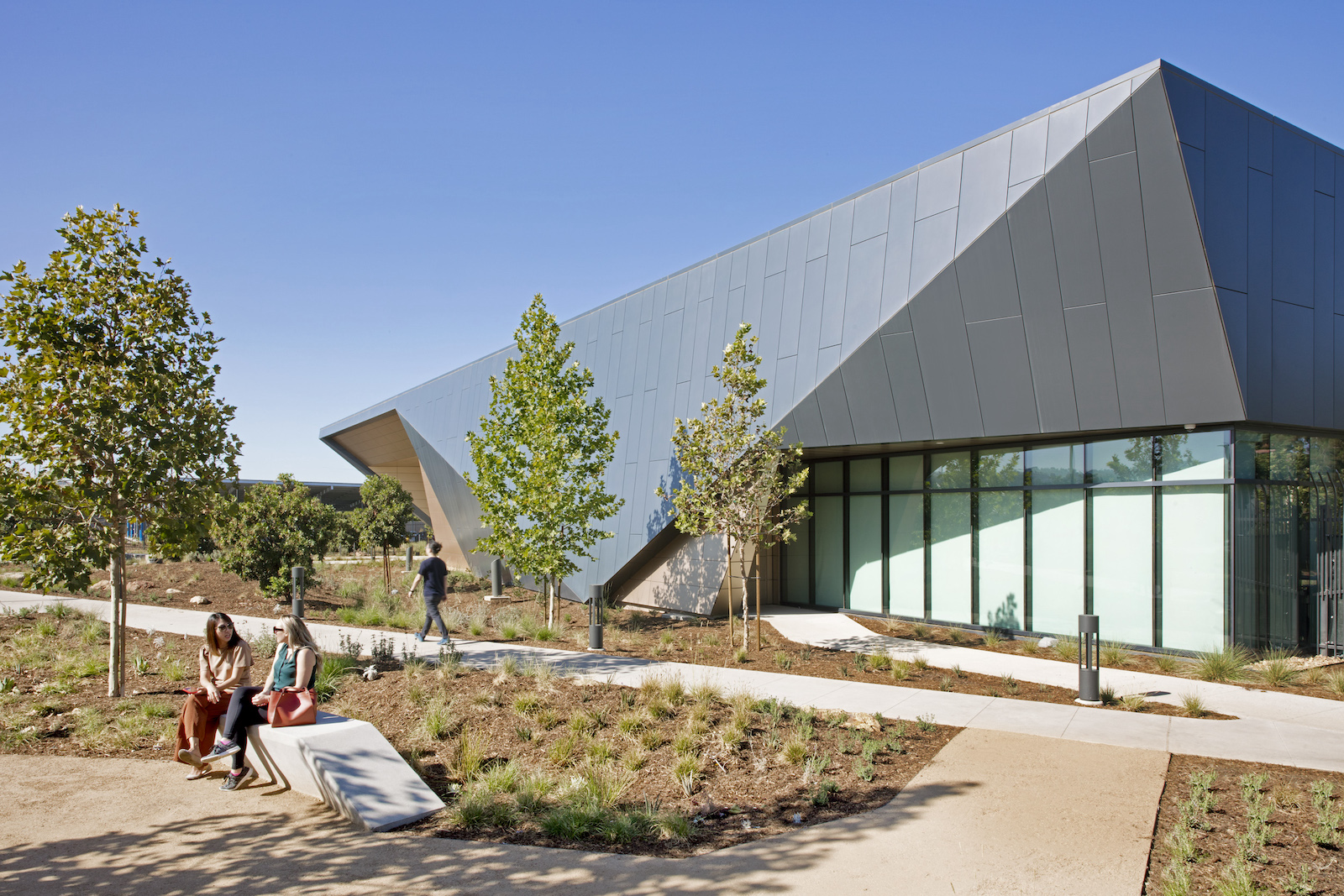The California Air Resources Board (CARB) Southern California headquarters has been completed in Riverside, Calif. The 403,306-sf is the largest vehicle emissions testing facility in the world and the largest net-zero facility of its kind.
The CARB headquarters exceeds California Title 24 requirements by 30% and lowers energy cost savings by 75%. All of the energy needed is produced onsite, making it resilient to power outages and protecting it from pausing its research operations.
CARB consolidated five existing locations across Southern California into CARB’s headquarters which improves performance and efficiency of operations while also providing a healthy workplace for the organization’s employees. The design team’s focus was not just reaching high-performance targets, but creating a quality environment for CARB’s employees.
The features of the headquarters include a complex program with myriad space types, including a main entrance and lobby, an employee entrance and lounge, a large auditorium, open office, conference room, light-and-heavy-duty vehicular emissions testing wings, specialized chemistry and hydrogen laboratories, and employee amenity spaces such as an expensive breakroom and a gym. The facility is sited on 19 acres to encourage biking, walking, public transit, and use of zero emissions vehicles to reduce transportation impacts.
The facility effectively connects users to the outdoors. The layout and form of the building establishes two principle outdoor spaces: the main courtyard to the east and a more private courtyard to the west. The building is oriented around the courtyards to lend itself to easy circulation, views, daylighting, and self-shading. Coupled with an abundance of low B VOC-emission trees and plantings, comfortable outdoor respite spaces are established for employee enjoyment.
The massing of the office building is consolidated into three stories that extend in three directions parallel to light duty testing, chemistry labs, and toward the conference buildings. This creates a smaller building footprint and shortens horizontal circulation networks, while using vertical connectivity established by a network of bridges and stairs to increase proximity between offices, testing areas, support spaces, and laboratories, resulting in increased flexibility, optimized adjacencies, and greater opportunities for intellectual collisions among employees. A variety of types and scales of meeting spaces, as well as coffee bars and cafés promote interaction and collaboration, especially for staff who circulate between the various departments throughout the day.
The ground floor of the open office atrium features testing control desks where employees conduct and operate the air regulation testing that occurs in the test cells. These inset spaces throughout the office building first floor are open and allow all users to see the AC dynamometers, among other testing equipment, in action.
Beyond putting CARB vehicular testing on display, the energy reduction strategies in the office building also largely contribute to the facility’s net-zero energy status. The integration of chilled beams allowed the atrium ceiling to be kept high, making way for the collection of skylights—a passive lighting strategy—that create expansive views of the naturally lit workspace. Paired with task lighting and daylighting harvesting, the office wing, which accounts for 41% of the total program, uses only 15% of the total energy needed to operate the building.

Energy reduction strategies include:
- Fluid cooler - Using hybrid coolers in conjunction with an elevated 570°F chilled water temperature reduced estimated energy consumption of the facility by approximately 8%.
- Aircuity and demand control ventilation - Continuous indoor air monitoring maximizes ventilation efficiency and energy reduction.
- Adiabatic humidification - Air is humidified without using steam or an additional heat source, reducing energy consumption.
- Active chilled beams - The hydronic air cooling system uses less air, reducing energy requirements and overall operating costs.
- Daylighting - Skylights increase interior daylighting. Motorized interior shades reduce glare.
- Lighting - Site lighting: high efficiency LED site in parking. Interior lighting: interiors incorporate all LED lighting, task-ambient lighting, daylight harvesting control, dual lighting / HVAC occupancy sensors.
- Electrical vehicle charging - 118 EV charging stalls provided on site with the ability to expand to a total of 149 EV parking stalls.
- Fume hood occupancy-based control - Occupancy-based sensors integrated into the chemistry lab fume hoods reduce energy demands.
- Exterior louvers - Exterior louvers integrated into the southeast and west facades reduce solar heating and glare.
- High-performance glazing - Low-e insulated glazing with exterior louvers increase operational energy efficiency.
The facility was completed in August 2021. ZGF worked with Hensel Phelps and Affiliated Engineers on the project.
Related Stories
| Jan 28, 2014
2014 predictions for skyscraper construction: More twisting towers, mega-tall projects, and 'superslim' designs
Experts from the Council on Tall Buildings and Urban Habitat release their 2014 construction forecast for the worldwide high-rise industry.
| Jan 28, 2014
16 awe-inspiring interior designs from around the world [slideshow]
The International Interior Design Association released the winners of its 4th Annual Global Excellence Awards. Here's a recap of the winning projects.
| Jan 13, 2014
Custom exterior fabricator A. Zahner unveils free façade design software for architects
The web-based tool uses the company's factory floor like "a massive rapid prototype machine,” allowing designers to manipulate designs on the fly based on cost and other factors, according to CEO/President Bill Zahner.
| Jan 11, 2014
Getting to net-zero energy with brick masonry construction [AIA course]
When targeting net-zero energy performance, AEC professionals are advised to tackle energy demand first. This AIA course covers brick masonry's role in reducing energy consumption in buildings.
| Dec 31, 2013
BD+C's top 10 stories of 2013
The world's tallest twisting tower and the rise of augmented reality technology in construction were among the 10 most popular articles posted on Building Design+Construction's website, BDCnetwork.com.
| Dec 27, 2013
U.S. Capitol dome’s cracks to be repaired during $60 million renovation
Rings of scaffolding will start to rise this spring around the cast-iron dome of the U.S. Capitol in Washington as part of a $60 million renovation project to repair more than 1,300 cracks.
| Dec 20, 2013
Can energy hogs still be considered efficient buildings? Yes, say engineers at Buro Happold
A new tool from the engineering firm Buro Happold takes into account both energy and economic performance of buildings for a true measure of efficiency.
| Dec 13, 2013
Safe and sound: 10 solutions for fire and life safety
From a dual fire-CO detector to an aspiration-sensing fire alarm, BD+C editors present a roundup of new fire and life safety products and technologies.
| Dec 10, 2013
16 great solutions for architects, engineers, and contractors
From a crowd-funded smart shovel to a why-didn’t-someone-do-this-sooner scheme for managing traffic in public restrooms, these ideas are noteworthy for creative problem-solving. Here are some of the most intriguing innovations the BD+C community has brought to our attention this year.
| Dec 9, 2013
Skaneateles, N.Y., converts old firehouse to net-zero village hall
The Finger Lakes village of Skaneateles, N.Y., renovated its vacant firehouse into Skaneateles Village Hall, the first municipal net-zero energy building in the state of New York.

















